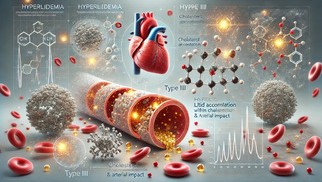Hyperlipidemia (Type 3): Answers to Popular Questions


Hyperlipidemia encompasses a group of disorders characterized by elevated levels of lipids (fats) in the blood. Among its classifications, Type III hyperlipidemia, also known as hyperlipoproteinemia type 3 or dysbetalipoproteinemia, stands out due to its unique genetic and metabolic underpinnings. This article explores Type III hyperlipidemia in detail, covering its causes, familial aspects, treatments, and distinctions from other forms like Type II hyperlipidemia.
What is Type 3 Hyperlipidemia?
Type III hyperlipidemia is a rare lipid metabolism disorder resulting from the abnormal accumulation of intermediate-density lipoproteins (IDLs) in the blood. This condition stems from a defect in the apolipoprotein E (ApoE) gene, specifically the homozygous presence of the ApoE2 isoform. ApoE is critical for the clearance of lipoprotein remnants from the bloodstream. When its function is impaired, these remnants accumulate, leading to elevated cholesterol and triglyceride levels.
Type 3 Hyperlipoproteinemia Symptoms
The symptoms of Type III hyperlipoproteinemia often manifest as a result of lipid accumulation and its impact on various tissues. One of the hallmark signs is the presence of xanthomas, which are yellowish, cholesterol-rich deposits that appear on the skin. These may include:
- Tuberous xanthomas: Nodular, firm lesions commonly found on pressure areas like the elbows, knees, and buttocks.
- Palmar xanthomas: Yellowish discolorations or streaks on the palms, particularly along the creases, which are considered highly characteristic of this condition.
Other symptoms include an increased risk of cardiovascular complications such as coronary artery disease, peripheral vascular disease, and cerebrovascular disease. Patients may also experience symptoms related to atherosclerosis, such as chest pain, claudication (leg pain during exercise), or even stroke in severe cases.
In some instances, the condition is asymptomatic until metabolic stressors like obesity, diabetes, or hypothyroidism exacerbate lipid imbalances, leading to clinical manifestations. Regular monitoring and early intervention are crucial for managing these symptoms and preventing severe complications.
What is Familial Hyperlipidemia Type 3?
Familial hyperlipidemia type 3 refers to the hereditary nature of this condition. As it is linked to genetic mutations in the ApoE gene, individuals with a family history of hyperlipidemia or premature cardiovascular disease are at higher risk. The ApoE gene exists in three major isoforms: ApoE2, ApoE3, and ApoE4. While ApoE3 is the most common and functional variant, ApoE2’s altered structure reduces its ability to bind to lipoprotein receptors effectively.
For someone to develop Type III hyperlipidemia, they generally need to inherit two copies of the ApoE2 allele (homozygous E2/E2). However, not all individuals with the E2/E2 genotype will manifest the disease. Environmental and secondary factors, such as a high-fat diet, sedentary lifestyle, or hormonal changes, often play a role in triggering the clinical expression of the disorder. Consequently, familial hyperlipidemia type 3 highlights the complex interplay between genetics and environmental influences.
How Do You Treat Type 3 Hyperlipidaemia?
Treatment of Type III hyperlipidemia focuses on managing lipid levels to reduce the risk of cardiovascular complications. A multifaceted approach, including lifestyle modifications, dietary changes, and pharmacological interventions, is often necessary.
Lifestyle and Dietary Changes
Adopting a healthy lifestyle is the cornerstone of managing Type III hyperlipidemia. Patients are encouraged to:
- Follow a low-fat diet: Reducing the intake of saturated fats and trans fats while increasing consumption of omega-3 fatty acids, fiber-rich foods, and plant sterols can significantly improve lipid profiles.
- Engage in regular physical activity: Aerobic exercises like walking, cycling, or swimming help enhance lipid metabolism and support weight management.
- Achieve and maintain a healthy weight: Obesity exacerbates the condition, so weight loss can reduce lipid levels and improve overall cardiovascular health.
- Quit smoking and limit alcohol: Both can worsen lipid abnormalities and increase cardiovascular risks.
Pharmacological Treatments
For many patients, lifestyle changes alone may not suffice, necessitating the use of medications. The primary drugs used to treat Type III hyperlipidemia include:
- Statins: These medications lower cholesterol levels by inhibiting HMG-CoA reductase, an enzyme involved in cholesterol synthesis. Statins also have anti-inflammatory properties that reduce cardiovascular risks.
- Fibrates: Fibrates, such as gemfibrozil (Lopid), are highly effective in lowering triglyceride levels and increasing HDL (good cholesterol).
- Niacin: This vitamin can help reduce both triglycerides and LDL cholesterol while boosting HDL levels.
- Ezetimibe: This medication reduces the absorption of cholesterol in the intestines.
- PCSK9 inhibitors: These newer agents lower LDL cholesterol by enhancing the clearance of lipoproteins from the blood.
Treatment with Lopid (Gemfibrozil)
Lopid (gemfibrozil) is one of the most commonly prescribed fibrates for managing Type III hyperlipidemia. This drug works by activating peroxisome proliferator-activated receptors (PPAR-α), which regulate the metabolism of lipids. Through this mechanism, gemfibrozil significantly reduces triglyceride levels and moderately decreases LDL cholesterol while promoting an increase in HDL cholesterol.
Benefits of Lopid
Gemfibrozil has been particularly effective in addressing the hallmark lipid abnormalities of Type III hyperlipidemia, including elevated triglycerides and cholesterol-rich remnants. By lowering these lipid levels, Lopid reduces the risk of atherosclerotic plaque formation and subsequent cardiovascular events. Additionally, this medication is generally well-tolerated, making it a suitable long-term option for many patients.
Dosage and Administration
The typical dosage of Lopid for adults with Type III hyperlipidemia is 600 mg taken twice daily, 30 minutes before meals. Adherence to the prescribed regimen is essential for optimal results.
Potential Side Effects
While Lopid is effective, it is not without potential side effects. Common adverse effects include gastrointestinal disturbances such as nausea, abdominal pain, and diarrhea. Rarely, patients may experience muscle-related symptoms, such as myopathy or rhabdomyolysis, especially when Lopid is combined with statins. Liver function abnormalities and gallstone formation are other possible concerns, warranting regular monitoring of liver enzymes and gallbladder health.
Precautions and Interactions
Patients should inform their healthcare providers of all medications they are taking, as Lopid can interact with drugs like statins, anticoagulants, and certain antidiabetic agents. Individuals with liver, kidney, or gallbladder disease may require alternative treatments.
In summary, Lopid remains a cornerstone in the pharmacological management of Type III hyperlipidemia, offering significant benefits for lipid control and cardiovascular risk reduction when used appropriately.
What is Type II Hyperlipidemia?
Type II hyperlipidemia, often referred to as familial hypercholesterolemia, differs from Type III in its genetic basis and lipid abnormalities. It is characterized by high levels of low-density lipoprotein (LDL) cholesterol due to mutations in the LDL receptor gene. This disorder is subdivided into:
- Type IIa: Marked by isolated elevation of LDL cholesterol.
- Type IIb: Features elevated LDL cholesterol and triglycerides, often accompanied by reduced HDL cholesterol.
Unlike Type III, Type II hyperlipidemia typically presents early in life and has a more pronounced familial component. Patients with this condition are at extremely high risk for premature atherosclerosis and cardiovascular disease. Treatment often involves aggressive lipid-lowering therapies, including high-potency statins, PCSK9 inhibitors, and lifestyle interventions.
Conclusion
Type III hyperlipidemia is a complex yet manageable lipid disorder with distinct genetic and metabolic characteristics. Early recognition and intervention are crucial to prevent severe cardiovascular complications. While lifestyle changes form the foundation of treatment, medications like Lopid play a pivotal role in achieving optimal lipid control. Understanding the nuances of Type III hyperlipidemia and its differences from other types, such as Type II, enables healthcare providers and patients to collaborate effectively in managing this condition and reducing its long-term impact.
Article post: Editorial Team of RXShop.md
(Updated at Jan 9 / 2025)